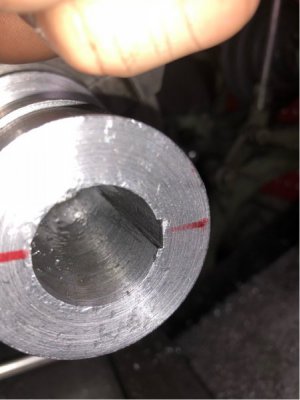- Joined
- Jan 25, 2015
- Messages
- 2,558
Some of you may have already seen in my recent thread where built a hand powered broacher for my old atlas TH42to do an internal keyway on a project I'm working on:
While it is getting the job done, it's slooooow.
But more importantly: it seems to catch and hang up quite a bit. I'm only advancing the cross slide .001 at a time, but there seems to be just enough play in the "piston" that it sometimes misses doing a full forward cut and you can feel it drag on the return. Then, it will go in hard or grab on the next stroke.
The OCD side of me says "bore a new holder to closer tolerances", but honestly I won't use this much ever again, if at all.
My cutting tool is a what you would expect from teh average DIY'er shop: HSS, leaned back 7 degrees, back rake cut and sides are undercut. Basically, a wedge.
IN all fairness to the tool and lathe, I am cutting a 3/16" keyway in steel, which is probably asking quite a lot of it:

It;s doing it, but it's pretty frustrating overall.
I saw a youtobe video where a gent was talking about "negative rake" on the tool for such a device (it's a point instead of a wedge, like this /\ instead of this |\ ) and that it cuts on both the forward and draw strokes. He was mostly talking about how it cuts twice as fast, but I'm more interested in it cutting on the draw stroke so it is less likely to catch on the next forward stroke. In a nutshell, I'm just looking to make what I've got run a little smoother.
Anyone ever hear of this or think it's work grinding up a blank to try?
While it is getting the job done, it's slooooow.
But more importantly: it seems to catch and hang up quite a bit. I'm only advancing the cross slide .001 at a time, but there seems to be just enough play in the "piston" that it sometimes misses doing a full forward cut and you can feel it drag on the return. Then, it will go in hard or grab on the next stroke.
The OCD side of me says "bore a new holder to closer tolerances", but honestly I won't use this much ever again, if at all.
My cutting tool is a what you would expect from teh average DIY'er shop: HSS, leaned back 7 degrees, back rake cut and sides are undercut. Basically, a wedge.
IN all fairness to the tool and lathe, I am cutting a 3/16" keyway in steel, which is probably asking quite a lot of it:

It;s doing it, but it's pretty frustrating overall.
I saw a youtobe video where a gent was talking about "negative rake" on the tool for such a device (it's a point instead of a wedge, like this /\ instead of this |\ ) and that it cuts on both the forward and draw strokes. He was mostly talking about how it cuts twice as fast, but I'm more interested in it cutting on the draw stroke so it is less likely to catch on the next forward stroke. In a nutshell, I'm just looking to make what I've got run a little smoother.
Anyone ever hear of this or think it's work grinding up a blank to try?
Last edited:

